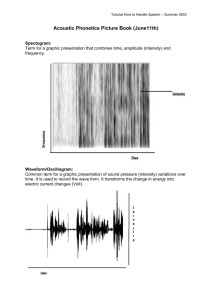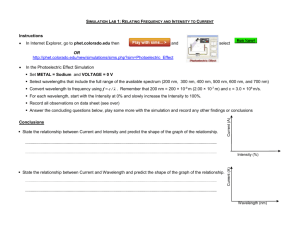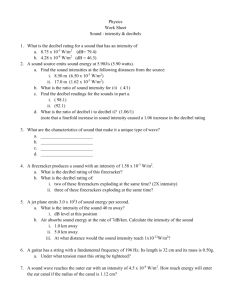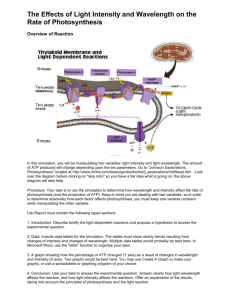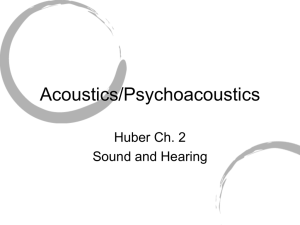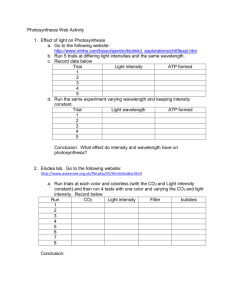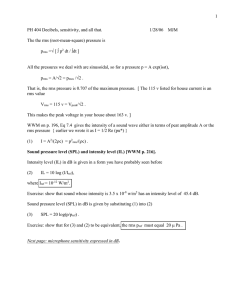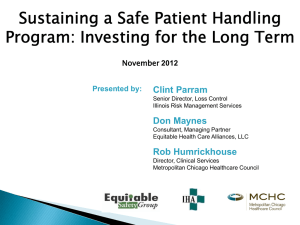free sample here
advertisement
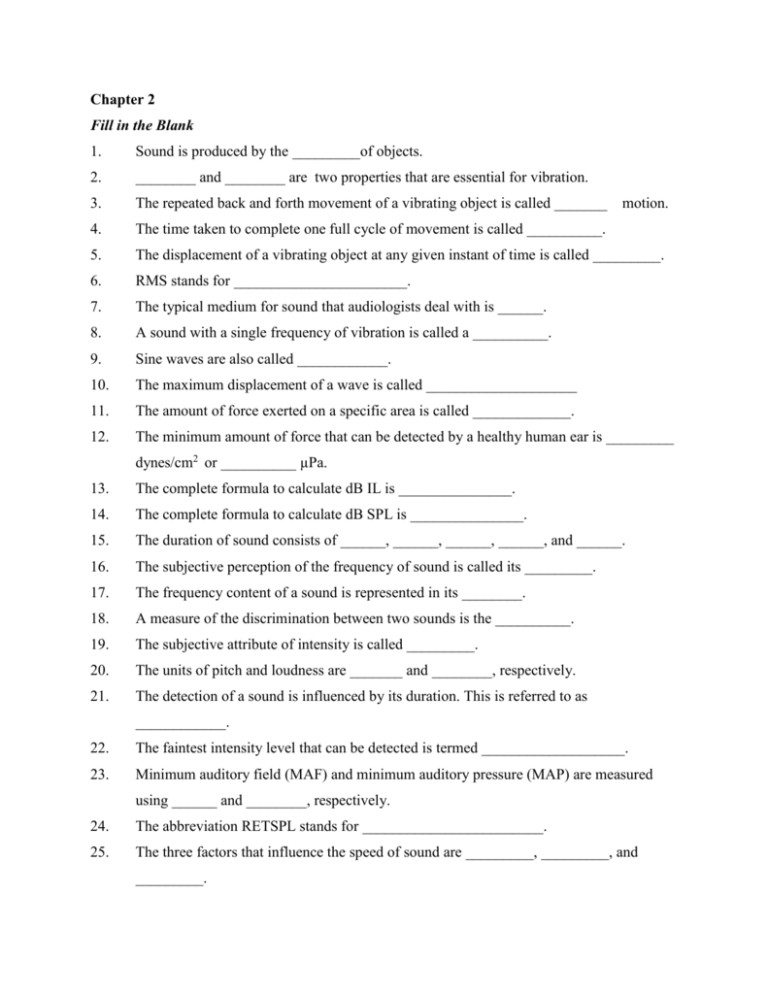
Chapter 2 Fill in the Blank 1. Sound is produced by the _________of objects. 2. ________ and ________ are two properties that are essential for vibration. 3. The repeated back and forth movement of a vibrating object is called _______ 4. The time taken to complete one full cycle of movement is called __________. 5. The displacement of a vibrating object at any given instant of time is called _________. 6. RMS stands for _______________________. 7. The typical medium for sound that audiologists deal with is ______. 8. A sound with a single frequency of vibration is called a __________. 9. Sine waves are also called ____________. 10. The maximum displacement of a wave is called ____________________ 11. The amount of force exerted on a specific area is called _____________. 12. The minimum amount of force that can be detected by a healthy human ear is _________ motion. dynes/cm2 or __________ µPa. 13. The complete formula to calculate dB IL is _______________. 14. The complete formula to calculate dB SPL is _______________. 15. The duration of sound consists of ______, ______, ______, ______, and ______. 16. The subjective perception of the frequency of sound is called its _________. 17. The frequency content of a sound is represented in its ________. 18. A measure of the discrimination between two sounds is the __________. 19. The subjective attribute of intensity is called _________. 20. The units of pitch and loudness are _______ and ________, respectively. 21. The detection of a sound is influenced by its duration. This is referred to as ____________. 22. The faintest intensity level that can be detected is termed ___________________. 23. Minimum auditory field (MAF) and minimum auditory pressure (MAP) are measured using ______ and ________, respectively. 24. The abbreviation RETSPL stands for ________________________. 25. The three factors that influence the speed of sound are _________, _________, and _________. 26. The speed of sound in air is ________ m/s. 27. A sound with more than one frequency in it is called ___________. 28. Sounds with very short durations are termed _______. 29. The human voice can be characterized in terms of its _______________ and higher frequencies called _________. True or False 30. The decibel called be described as a relative, logarithmic unit involving the ratio of a given pressure or power to a reference pressure or power. 31. The units dB SPL, dB SL, and dB HL can all be interchangeably used. 32. Loudness and intensity can be used interchangeably with each other. 33. RETSPLS are the same regardless of the transducer used to measure them. 34. Sound intensity is indirectly proportional to the distance between the receiver and the source of sound. 35. Constructive and destructive interference can change the intensity of sound. Multiple Choice 36. Which of the following statements is true? a. Sound can travel in any medium as long as the medium contains particles. b. Sound can travel only in air. c. Sound cannot travel in water. d. Sound can travel in a vacuum (a space where there are no particles.) 37. Which of the following property-unit pair is appropriately matched? a. Wavelength- Hertz b. Frequency – Second c. Speed of sound – Meters/second d. Time period – cps 38. The tendency of a body to maintain a state of rest or uniform motion unless acted upon by an external force is called a. Vibration b. Elasticity c. Inertia d. Damping 39. The wavelength of a sound wave is defined as the distance between a. Two successive condensations only b. Two successive rarefactions only c. Two successive rarefactions or condensations d. One rarefaction and the next condensation 40. The gradual decrease in the amplitude of vibration over time is called a. Inertia b. Resistance c. Damping d. Resistance 41. What is the wavelength of a sound with a frequency of 10 Hz? a. 345 m b. 3.45 m c. 34.5 m d. 10 m 42. Which of the following is related to the amplitude of vibration a. Intensity b. Wavelength c. Frequency d. Phase 43. Psychoacoustics is the branch of science that deals with the a. Relation between the anatomy and the physiology of the auditory system b. Relation between the anatomy of the auditory system and the physical aspects of sound c. Relation between the physical aspects of sound and the physiology of the auditory system d. Relation between the physical aspects of sound and the perception of sound 44. An area with a high concentration of air particles is called a. Condensation b. Rarefaction c. Vacuum d. Anechoic chamber 45. Jane’s threshold for a 2000 Hz pure tone is 40 dB SPL. What is the sensation level for a 2000 Hz presented to Jane at 50 dB SPL? a. 50 dB SPL b. 40 dB IL c. 90 dB HL d. 10 dB SL Short Answer 46. Name the three dimensions shown in a spectrogram. 47. List three different sounds that are used by audiologist in their daily practice. 48. List three properties of sound that are manipulated by audiologists. 49. Name three noises used by audiologists in their daily practice. 50. What is the relation between time period and frequency? 51. How are frequency and wavelength related? 52. What is the rationale behind the dB as a unit of sound intensity? 53. Define dB SL. 54. Define dB HL Chapter 2 1. Vibration 2. Inertia and elasticity 3. Simple harmonic motion 4. Time period 5. Instantaneous displacement 6. Root mean square 7. Air 8. Sine wave 9. Pure tones 10. Peak amplitude 11. Pressure 12. 0.0002, 20 13. 10 log (I2/IR) 14. 20 log (P2/PR) 15. Onset, rise time, plateau, fall time, offset 16. Pitch 17. Spectrum 18. Just noticeable difference (JND) 19. Loudness 20. Mel, phon 21. Temporal integration 22. Threshold of audibility 23. Loudspeakers, earphones 24. Reference equivalent threshold sound pressure level 25. Temperature, humidity, barometric pressure 26. 345 27. Complex sound 28. Transients 29. Fundamental frequency, formants 30. True 31. False 32. False 33. False 34. True 35. True 36. a, Sound can travel in any medium as long as the medium contains particles 37. c, Speed of sound – Meters/second 38. b, Inertia 39. c, Two successive rarefactions or condensations 40. c, damping 41. c, 34.5 m 42. a, intensity 43. d, Relation between the physical aspects of sound and the perception of sound 44. a, Condensation 45. d, 10 dB SL 46. Frequency (vertical axis), time (horizontal axis), and intensity (degree of shading) 47. Sine waves/pure tones, speech, and noise 48. Intensity, frequency, duration 49. Broadband noise, narrow band noise, speech spectrum noise 50. Frequency = 1/Time period. Frequency is the number of cycles in one second, while time period is the time taken to complete one cycle. They are inversely proportional to each other. 51. Wavelength = Speed of sound/Frequency 52. The human ear is capable of responding to a huge range of sounds ranging from very soft to painful, when expressed in absolute units such as w/m2 and µPa. In order to compress these numbers into a range that is more practical for clinical use, the logarithm is applied to a ratio of the measured sound power or pressure to a known reference. This unit is called decibel. 53. The unit dB SL stands for decibel sensation level. It is defined as the level of sound that is above the threshold of audibility or detection. For example, if a person’s threshold of detection for a sound is 10 dB SPL, and the same sound is presented now at 65 dB SPL, the sensation level would be 65 -10 = 55 dB SL. 54. The unit dB HL stands for decibel hearing level. 0 dB HL is defined as the lowest intensity that a normal hearing person can hear (at any frequency). dB HL can be converted to the corresponding dB SPL using the appropriate RETSPL value. For example, 0 dB HL at 1000 Hz corresponds to 7.5 dB SPL (0 +7.5) when measured using TDH earphones.

